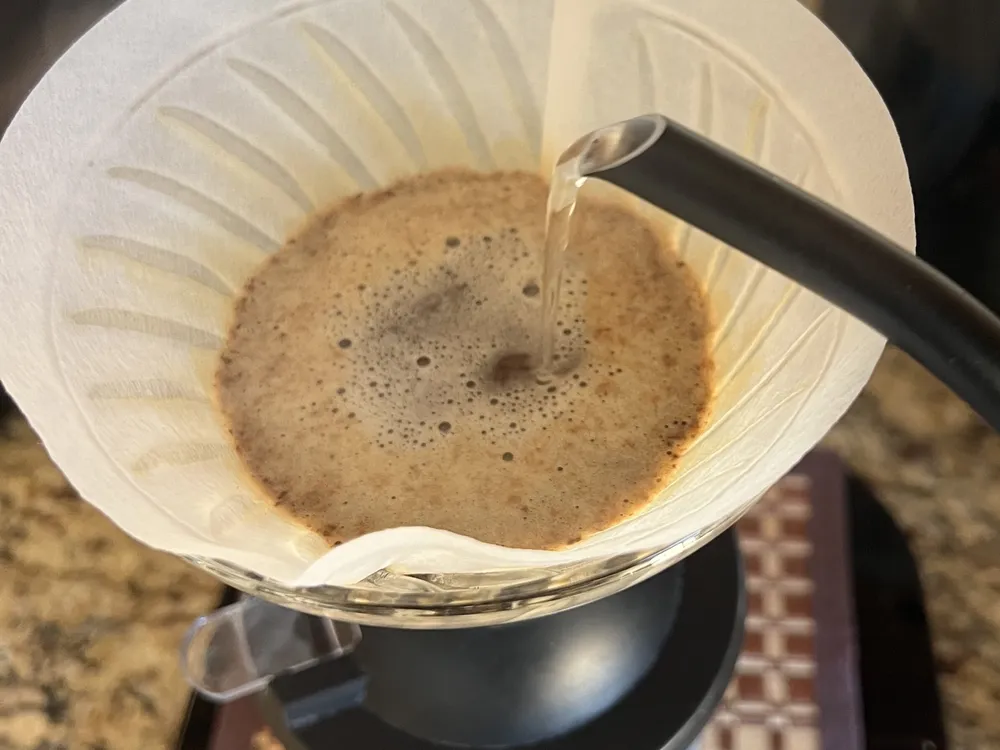Here's the Secret to Making the Perfect Cup of Pour-Over Coffee, According to Physicists
Here’s the Secret to Making the Perfect Cup of Pour-Over Coffee, According to Physicists
By adjusting the pouring technique and height, the new method could use 10 percent fewer coffee grounds without compromising on strength or flavor
A cup of pour-over coffee is prepared by researchers at the University of Pennsylvania.
Ernest Park
Physicists say they’ve found the best way to make pour-over coffee, and it’s surprisingly simple.
With coffee prices rising over the last few years and climate change affecting crops, a new technique can help make the most of your increasingly precious coffee grounds, researchers say. The new method was published in the journal Physics of Fluids on Tuesday.
“Coffee is getting harder to grow, and so, because of that, prices for coffee will likely increase in coming years,” says Arnold Mathijssen, a physicist at the University of Pennsylvania and study co-author, to Matthew Sparkes at New Scientist. “The idea for this research was really to see if we could help do something by reducing the amount of coffee beans that are needed while still keeping the same amount of extraction, so that you get the same strength of coffee.”
Mathijssen tells Elizabeth Weise at USA Today that the inspiration for this study started with Ernest Park, one of his PhD students. Park tested different ways of making pour-over coffee—when water is poured atop coffee grounds in a cone-shaped filter—and wrote the results in a logbook. “Initially he was just trying out different things, pouring coffee from different heights and such. Then he said: ‘Wait. This tastes good, but we need to do the actual experiments,’” says Mathijssen to USA Today.
So, the researchers conducted a series of tests, shifting the pour height and rate of water flow. First, they put silica gel particles in a glass cone as a substitute for ground coffee and used a high-resolution camera to capture the dynamics between the gel and the water. Then, they tested different pouring techniques with real coffee.
They found that a slow pour was best, to maximize extraction from the coffee grounds. At low heights, though, the water’s velocity was too slow to effectively move through the coffee bed. At higher heights, the water mixed with the particles more, creating a stronger brew. A steady flow created an “avalanche” effect, which both penetrated the coffee bed and recirculated the displaced grounds at the bottom of the funnel.
“The increased height compensates for the slow pouring. You only get the avalanche if there is enough energy available,” Mathijssen says to the Guardian’s Nicola Davis.
Pour-Over Coffee Silica Gel Experiment
Watch on
This process is also efficient—the research team estimates that you can use around 10 percent less ground coffee by employing their technique, without losing any flavor. To back this up with data, they measured the dissolved solids in cups of coffee made with various pouring methods. They found that their new technique did not compromise the coffee’s strength.
You don’t need anything too fancy for your morning cup of joe: Just slowly and steadily add water from a goose-neck kettle while increasing the pour height to about 11 inches, the researchers advise. But be careful not to disrupt the stream. “If you pour too slowly, or if you go too high, then the jet tends to break up into these smaller droplets, and that’s what you want to avoid as well,” Mathijssen explains to the Guardian.
If you get a thin stream of droplets rather than a steady water flow, “that means the jet cannot mix the coffee grounds effectively,” study co-author Margot Young, also a physicist at the University of Pennsylvania, says in a statement.
Put simply, “be reasonable,” Mathijssen adds to New Scientist. “First, try to be slow. Then lift [the kettle] up and go as slow as you can, but don’t let [the flow of water] break up,” he adds. “That’s the strategy that I would follow.”
Now, when you wake up tomorrow morning, you can make a scientifically perfect pour-over with your scientifically perfect boiled egg, and have a delicious breakfast.
Get the latest stories in your inbox every weekday.
More about:
Coffee
New Research
Physics
Water


